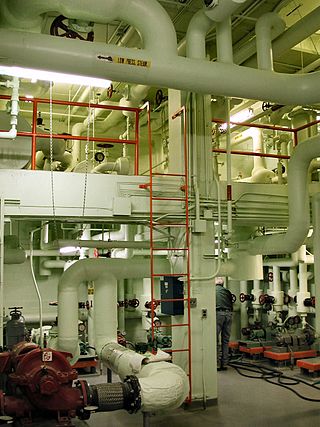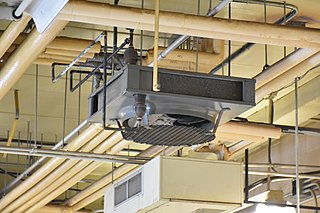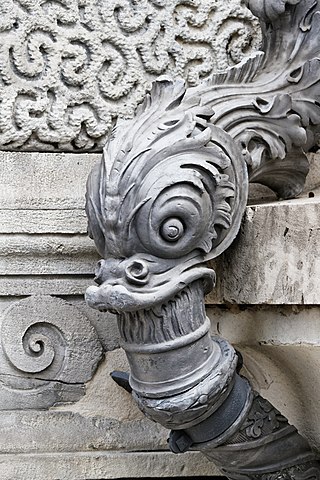
A pipeline is a system of pipes for long-distance transportation of a liquid or gas, typically to a market area for consumption. The latest data from 2014 gives a total of slightly less than 2,175,000 miles (3,500,000 km) of pipeline in 120 countries around the world. The United States had 65%, Russia had 8%, and Canada had 3%, thus 76% of all pipeline were in these three countries. The main attribute to pollution from pipelines is caused by corrosion and leakage

A fire sprinkler system is an active fire protection method, consisting of a water supply system providing adequate pressure and flowrate to a water distribution piping system, to which fire sprinklers are connected. Although initially used only in factories and large commercial buildings, systems for homes and small buildings are now available at a cost-effective price.

Vermont Yankee was an electricity generating nuclear power plant, located in the town of Vernon, Vermont, in the northeastern United States. It generated 620 megawatts (MWe) of electricity at full power. The plant was a boiling water reactor (BWR), designed by General Electric. It operated from 1972 until December 29, 2014, when its owner Entergy shut down the plant. In 2008, the plant provided 71.8% of all electricity generated within Vermont, amounting to 35% of Vermont's electricity consumption. The plant is on the Connecticut River, upstream of the Vernon, Vermont Hydroelectric Dam and used the reservoir pool for its cooling water.

Within industry, piping is a system of pipes used to convey fluids from one location to another. The engineering discipline of piping design studies the efficient transport of fluid.

An underground storage tank (UST) is, according to United States federal regulations, a storage tank, including any underground piping connected to the tank, that has at least 10 percent of its volume underground.

Hydronics is the use of liquid water or gaseous water (steam) or a water solution as a heat-transfer medium in heating and cooling systems. The name differentiates such systems from oil and refrigerant systems.
Cross-linked polyethylene, commonly abbreviated PEX, XPE or XLPE, is a form of polyethylene with cross-links. It is used predominantly in building services pipework systems, hydronic radiant heating and cooling systems, domestic water piping, insulation for high tension electrical cables, and baby play mats. It is also used for natural gas and offshore oil applications, chemical transportation, and transportation of sewage and slurries. PEX is an alternative to polyvinyl chloride (PVC), chlorinated polyvinyl chloride (CPVC) or copper tubing for use as residential water pipes.

The Red Hill Bulk Fuel Storage Facility is a military fuel storage facility in Hawaii. Operated by the United States Navy, Red Hill supports U.S. military operations in the Pacific.

A pipe is a tubular section or hollow cylinder, usually but not necessarily of circular cross-section, used mainly to convey substances which can flow — liquids and gases (fluids), slurries, powders and masses of small solids. It can also be used for structural applications; hollow pipe is far stiffer per unit weight than solid members.
Polybutylene (polybutene-1, poly(1-butene), PB-1) is a polyolefin or saturated polymer with the chemical formula (CH2CH(Et))n. Not be confused with polybutene, PB-1 is mainly used in piping.

Plastic pipe is a tubular section, or hollow cylinder, made of plastic. It is usually, but not necessarily, of circular cross-section, used mainly to convey substances which can flow—liquids and gases (fluids), slurries, powders and masses of small solids. It can also be used for structural applications; hollow pipes are far stiffer per unit weight than solid members.
Pipeline leak detection is used to determine if and in some cases where a leak has occurred in systems which contain liquids and gases. Methods of detection include Active Micropulse Sonar, hydrostatic testing, tracer gas leak detection, infrared, and laser technology after pipeline erection and leak detection during service.
The Pressure Pipe Inspection Company (PPIC) is a supplier of large-diameter water and wastewater pipeline condition assessment and leak-detection services in Mississauga, Ontario. It specializes in identifying damaged pipeline sections to protect infrastructure investment, locate leaks, reduce risk and ensure environmental compliance. Its services include:
Mueller Systems is a manufacturer and distributor of advanced metering infrastructure (AMI) and automatic meter reading (AMR) technology, as well as residential, commercial and fire-line meters and related products. It is a subsidiary of Mueller Water Products. Founded as Hawes and Hersey Company in 1859, Mueller Systems is the oldest manufacturer of water meters in the United States.
Mueller Water Products, Inc. (MWP) is a publicly traded company headquartered in Atlanta, Georgia. It is one of the largest manufacturers and distributors of fire hydrants, gate valves, and other water infrastructure products in North America. MWP is made up of two business units—Mueller Co. and Mueller Technologies—that oversee more than a dozen brands and affiliates, including Echologics and Mueller Systems.
Mueller Co. is a Chattanooga, Tennessee based industrial manufacturing group that manufactures fire hydrants, gate valves, and other water distribution products. Mueller Co. which moved to Chattanooga from Decatur, Illinois in 2010, is the largest supplier of potable water distribution products in North America. Mueller Co. is a subsidiary of Mueller Water Products, Inc. A manufacturing facility remains in Decatur.
Electro Scan Inc. is a designer and manufacturer of water and sewer machine-intelligent pipeline inspection devices and provider of Software-as-a-Service (SaaS) based cloud reporting. The company utilizes electric currents to detect leaks in non-conductive sewer pipes. The company is based in Sacramento, California, with additional offices in London, England and Toronto, Canada.
HDPE pipe is a type of flexible plastic pipe used to transfer fluids and gases. It is often employed for replacing aging concrete or steel main pipelines. Constructed from the thermoplastic HDPE, it has low permeability and robust molecular bonding, making it suitable for high-pressure pipelines. HDPE pipe is often used for water mains, gas mains, sewer mains, slurry transfer lines, rural irrigation, fire-suppression system supply lines, electrical and communication conduits, and stormwater and drainage pipes.
A variety of non-destructive examination (NDE) techniques are available for inspecting plastic welds. Many of these techniques are similar to the ones used for inspecting metal welds. Traditional techniques include visual testing, radiography, and various ultrasonic techniques. Advanced ultrasonic techniques such as time of flight diffraction (TOFD) and phased-array ultrasonics (PAUT) are being increasingly studied and used for inspecting plastic pipeline welds. Research in the use of optical coherence tomography (OCT) and microwave reflectrometry has also been conducted.

A water distribution system is a part of water supply network with components that carry potable water from a centralized treatment plant or wells to consumers to satisfy residential, commercial, industrial and fire fighting requirements.










